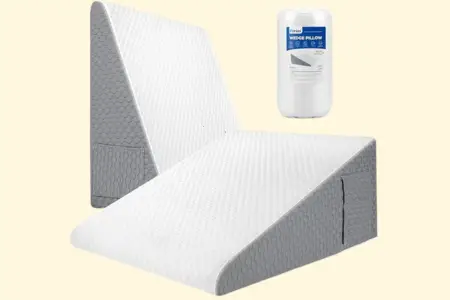The best way to stack pillows for acid reflux is to elevate your upper body at a 30 to 45-degree angle. Use wedge-shaped pillows for optimal support and comfort.
Acid reflux can disrupt your sleep, causing discomfort and restlessness. Elevating your upper body helps prevent stomach acid from traveling back into your esophagus. Using wedge-shaped pillows provides consistent support, ensuring a gradual incline. Traditional pillows can shift and flatten, making them less effective.
Why Stacking Pillows Helps With Acid Reflux
The best way to stack pillows for acid reflux can improve your sleep significantly. Let’s explore why stacking pillows helps with acid reflux.
The Connection Between Sleeping Position And Acid Reflux
Your sleeping position plays a crucial role in acid reflux. Lying flat can make it easier for stomach acid to travel back up the esophagus. This leads to heartburn and other uncomfortable symptoms. Elevating your head can help prevent this.
Here’s why your sleeping position matters:
- Gravity: When you lie flat, gravity can’t help keep the acid down.
- Esophageal Position: A flat position makes it easier for acid to move up the esophagus.
- Stomach Position: Your stomach contents are more likely to stay put when your head is elevated.
Research supports the benefits of an elevated sleeping position. Studies show that raising the head of the bed can reduce acid reflux symptoms. The same principle applies to stacking pillows.
Let’s look at a few key points:
| Flat Position | Elevated Position |
|---|---|
| Increases acid reflux | Reduces acid reflux |
| Uncomfortable sleep | Comfortable sleep |
| More heartburn | Less heartburn |
How Elevating Your Head Reduces Acid Reflux Symptoms
Elevating your head while sleeping helps manage acid reflux. This position keeps stomach acids from moving up into the esophagus. Stacking pillows is a simple way to achieve this.
Here’s how elevating your head helps:
- Gravity: Gravity keeps the acid in your stomach when your head is higher than your stomach.
- Less Pressure: Elevation reduces pressure on the lower esophageal sphincter (LES), the muscle that keeps acid in the stomach.
- Better Digestion: An elevated position aids digestion by keeping acids in the stomach.
To effectively stack pillows:
- Use 2-3 firm pillows.
- Arrange them so that your head and upper body are elevated.
- Ensure your neck and back are supported.
A comfortable and elevated position can improve sleep quality. Consistent use of stacked pillows can lead to fewer acid reflux episodes. This method is simple yet highly effective.
Pillow for Acid Reflux

The Best Way To Stack Pillows For Acid Reflux Relief
Let’s explore the best techniques and tips for stacking pillows to relieve acid reflux.
How High Should You Stack Pillows For Optimal Relief?
To achieve optimal relief from acid reflux, it’s important to elevate your head and chest while sleeping. Experts recommend raising your head by about 6 to 8 inches, as this elevation can help prevent stomach acid from flowing back into the esophagus(Amerisleep).
You can achieve this height in different ways:
- Using 2-3 firm pillows: Place one pillow on top of the other, ensuring they are firm enough to hold your weight.
- Wedge pillows: These specially designed pillows provide a gradual incline.
- Adjustable beds: These beds allow you to elevate the head portion to the desired height.
Here’s a quick reference table:
| Method | Recommended Height | Notes |
|---|---|---|
| 2-3 Firm Pillows | 6-8 inches | Ensure pillows are firm |
| Wedge Pillows | 6-8 inches | Provides a gradual incline |
| Adjustable Beds | 6-8 inches | Customizable height |
It’s essential to maintain a comfortable and sustainable height. Too much elevation can strain your neck and back, while too little may not provide the relief you need.
Choosing The Right Pillows For Stacking
Selecting the right pillows is crucial for effective stacking and relief. Not all pillows are created equal. Here are some factors to consider:
- Firmness: Firm pillows offer better support and maintain their shape. Soft pillows may flatten out, reducing effectiveness.
- Material: Memory foam pillows provide excellent support and contour to your body. Latex pillows are also a great option for firmness and durability.
- Size: Standard or queen-sized pillows work best for stacking. Avoid overly large pillows as they can be difficult to manage.
- Breathability: Pillows with good airflow can keep you cool and comfortable throughout the night.
Here’s a comparison table to help you choose:
| Type | Advantages | Disadvantages |
|---|---|---|
| Memory Foam | Contours to body, excellent support | Can retain heat |
| Latex | Firm, durable, hypoallergenic | Expensive |
| Feather | Soft, adjustable | May flatten, not ideal for stacking |
Choosing the right pillows can make a significant difference in managing acid reflux and improving sleep quality. Opt for pillows that provide adequate support and maintain their shape throughout the night.

Step-by-step Guide To Stacking Pillows For Acid Reflux
Acid reflux can make sleeping a challenge. Stacking pillows correctly can help. This step-by-step guide will show you the best way to stack pillows for acid reflux. Follow these tips to improve your sleep quality and wake up feeling refreshed.
Positioning The Pillows For Maximum Comfort And Support
To reduce acid reflux symptoms, you need to elevate your upper body. Proper pillow positioning is key. Follow these steps to stack pillows for maximum comfort and support:
- Start with a firm pillow: Place a firm pillow at the base. This will provide a solid foundation.
- Add a medium-firm pillow: Place a medium-firm pillow on top of the firm pillow. This helps to create a gentle incline.
- Top it with a soft pillow: Finally, add a soft pillow on top for added comfort. This will cradle your head and neck.
Make sure the incline is around 30 to 45 degrees. This angle helps keep stomach acid down. Your head and neck should be supported without causing strain.
| Pillow Type | Position | Purpose |
|---|---|---|
| Firm Pillow | Base | Provides solid foundation |
| Medium-Firm Pillow | Middle | Creates gentle incline |
| Soft Pillow | Top | Adds comfort |
Ensure the pillows are aligned properly. A misaligned stack can cause neck pain. Adjust the pillows until you find a comfortable position that maintains the incline.
Tips For Keeping Pillows In Place Throughout The Night
Pillows can shift during the night. Use these tips to keep them in place:
- Use a pillow wedge: A pillow wedge can provide a stable base. Place it under the stacked pillows.
- Secure pillows with a towel: Roll a towel and place it at the bottom of the stack. This helps prevent slipping.
- Choose pillows with non-slip covers: Non-slip covers help keep pillows in place. Look for covers with grip material.
You can also use a pillowcase to hold multiple pillows together. This creates a single, stable unit. It’s a simple way to prevent shifting.
Consider the bed’s surface: A slippery mattress can cause pillows to move. Use a mattress pad with grip to reduce movement.
Experiment with different setups. Everyone’s comfort needs are different. Adjust the arrangement until you find what works best for you.

Alternatives To Pillow Stacking For Acid Reflux Relief
There are better alternatives to pillow stacking for acid reflux relief. These alternatives provide better support and comfort, ensuring a good night’s sleep.
Using Wedge Pillows For Better Elevation
Wedge pillows offer a simple, effective solution for acid reflux. These pillows elevate the upper body, preventing stomach acid from reaching the esophagus. Here are some key benefits:
- Improved Elevation: Wedge pillows provide consistent elevation, unlike stacked pillows that can shift during the night.
- Better Support: They offer firm support, reducing strain on the neck and back.
- Ease of Use: Simply place the wedge pillow on your bed and lay down.
Wedge pillows come in various sizes and materials. Here is a comparison table for different types:
| Type | Material | Features |
|---|---|---|
| Memory Foam | Foam | Contours to the body, provides good support |
| Inflatable | Plastic | Adjustable height, portable |
| Polyester Fiber | Fiber | Softer, less firm support |
Choose the type that best fits your needs for comfort and support. Memory foam is popular for its contouring ability. Inflatable wedges are great for travel. Polyester fiber is softer but may not offer the same support.
Adjustable Beds: A Long-term Solution For Acid Reflux
Adjustable beds are an excellent long-term investment for those suffering from acid reflux. These beds allow you to elevate the head and upper body, providing consistent relief. Here are some benefits:
- Customizable Positions: You can adjust the bed to your preferred angle, ensuring comfort.
- Enhanced Comfort: Adjustable beds provide better overall support, reducing strain on the body.
- Long-Term Investment: Though more expensive, they offer long-term benefits and improved sleep quality.
Consider the following features when choosing an adjustable bed:
- Remote Control: Easy adjustments at the touch of a button.
- Massage Features: Some models offer massage functions for added relaxation.
- Dual Adjustments: Allows separate adjustments for both sides of the bed.
Adjustable beds provide a seamless solution for acid reflux relief. They ensure you sleep in an elevated position without the hassle of stacking pillows. This investment can significantly improve your sleep quality and overall well-being.
Additional Tips To Reduce Acid Reflux During Sleep
Let’s explore additional tips to reduce acid reflux during sleep. These tips will help you achieve a more restful night.
Sleep Position Recommendations For Acid Reflux Sufferers
Choosing the right sleep position is crucial for those with acid reflux. Sleeping on your left side can significantly reduce symptoms. This position keeps your stomach below the esophagus, preventing acid from rising.
Elevating the head of your bed is another effective strategy. Use blocks or risers to lift the bed head by 6-8 inches. This elevation helps gravity keep stomach acid down.
For a quick overview, refer to the table below:
| Sleep Position | Benefits |
|---|---|
| Left Side | Keeps stomach below esophagus |
| Right Side | May worsen acid reflux |
| Back | Neutral, but elevate head |
| Stomach | Not recommended |
Avoid sleeping on your right side or stomach. These positions can increase reflux symptoms. If you prefer sleeping on your back, ensure your head and shoulders are elevated.
Consider using a wedge pillow. These pillows are designed to elevate the upper body and reduce acid reflux. They provide a gentle slope, unlike stacking regular pillows.
Other Lifestyle Changes To Improve Acid Reflux Symptoms
Besides sleep position, lifestyle changes can greatly impact acid reflux. Dietary adjustments are essential. Avoid trigger foods such as:
- Spicy foods
- Chocolate
- Caffeine
- Alcohol
- Fried foods
Eating smaller meals can also help. Large meals can increase pressure on the stomach, causing reflux. Try eating dinner at least 3 hours before bedtime. This allows time for digestion, reducing nighttime reflux.
Weight management is another key factor. Excess weight can put pressure on the abdomen, pushing stomach contents upward. Regular exercise and a healthy diet can help maintain a healthy weight.
Avoid smoking. Smoking can weaken the lower esophageal sphincter, making reflux more likely. Quitting smoking can improve overall health and reduce reflux symptoms.
Wearing loose clothing can also help. Tight clothes can press on the stomach and increase reflux. Opt for comfortable, loose-fitting garments, especially around bedtime.



